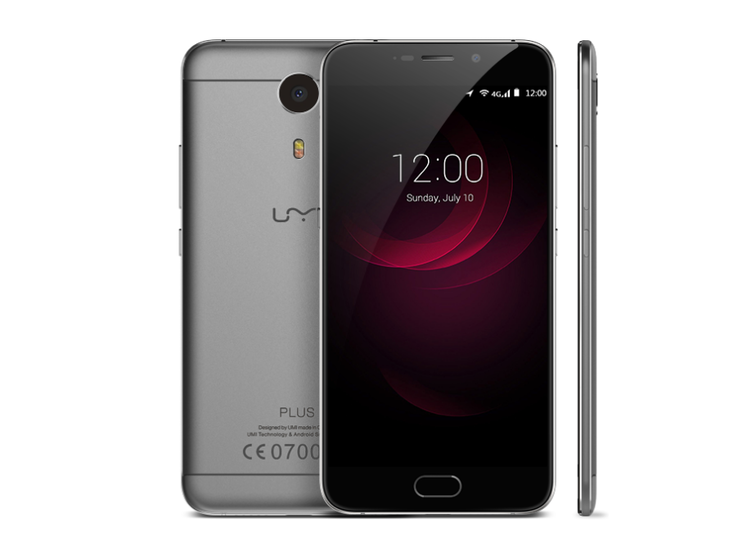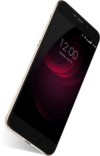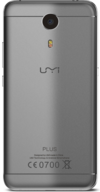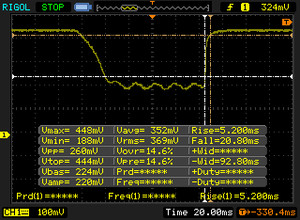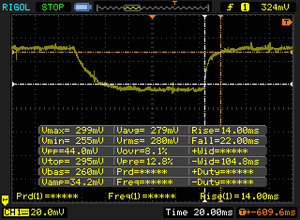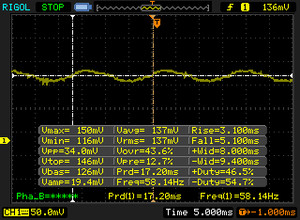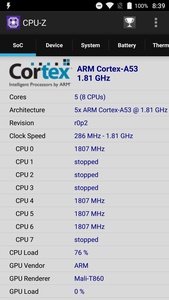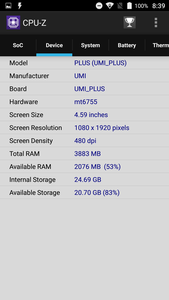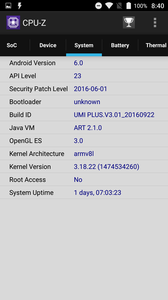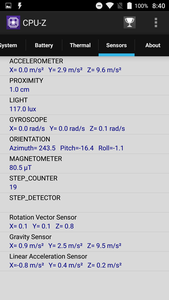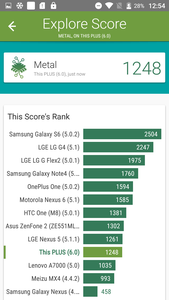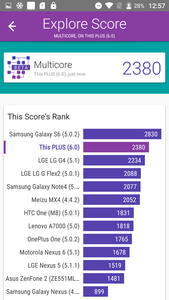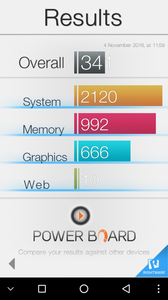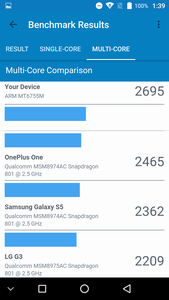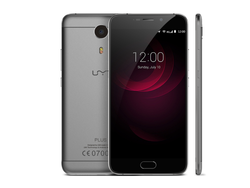UMI Plus 智能手机简短评测
» Notebookcheck多媒体笔记本电脑Top 10排名
» Notebookcheck游戏笔记本电脑Top 10排名
» Notebookcheck低价办公/商务笔记本电脑Top 10排名
» Notebookcheck高端办公/商务笔记本电脑Top 10排名
» Notebookcheck工作站笔记本电脑Top 10排名
» Notebookcheck亚笔记本电脑Top 10排名
» Notebookcheck超级本产品Top 10排名
» Notebookcheck变形本产品Top 10排名
» Notebookcheck平板电脑Top 10排名
» Notebookcheck智能手机Top 10排名
» Notebookcheck评测过最出色的笔记本电脑屏幕
» Notebookcheck售价500欧元以下笔记本电脑Top 10排名
» Notebookcheck售价300欧元以下笔记本电脑Top 10排名
| |||||||||||||||||||||||||
Brightness Distribution: 86 %
Center on Battery: 432.8 cd/m²
Contrast: 1866:1 (Black: 0.232 cd/m²)
ΔE ColorChecker Calman: 4.93 | ∀{0.5-29.43 Ø4.78}
ΔE Greyscale Calman: 5.18 | ∀{0.09-98 Ø5}
Gamma: 2.4
CCT: 7461 K
| UMI Plus LTPS, 5.5", 1920x1080 | UMI Max Sharp, IPS, 5.5", 1920x1080 | Sony Xperia XZ IPS, 5.2", 1920x1080 | ZTE Axon 7 AMOLED, 5.5", 2560x1440 | Asus Zenfone 3 ZE552KL IPS, 5.5", 1920x1080 | |
|---|---|---|---|---|---|
| Response Times | -25% | -88% | 88% | -47% | |
| Response Time Grey 50% / Grey 80% * (ms) | 36 ? | 40 ? -11% | 52 ? -44% | 4.8 ? 87% | 56 ? -56% |
| Response Time Black / White * (ms) | 26 ? | 36 ? -38% | 60 ? -131% | 3.2 ? 88% | 36 ? -38% |
| PWM Frequency (Hz) | 240.4 ? | ||||
| Screen | -13% | -13% | -11% | -18% | |
| Brightness middle (cd/m²) | 432.8 | 522 21% | 544 26% | 328 -24% | 658 52% |
| Brightness (cd/m²) | 430 | 498 16% | 521 21% | 334 -22% | 633 47% |
| Brightness Distribution (%) | 86 | 86 0% | 93 8% | 88 2% | 93 8% |
| Black Level * (cd/m²) | 0.232 | 0.23 1% | 0.37 -59% | 0.66 -184% | |
| Contrast (:1) | 1866 | 2270 22% | 1470 -21% | 997 -47% | |
| Colorchecker dE 2000 * | 4.93 | 6.9 -40% | 5.8 -18% | 4.6 7% | 4.9 1% |
| Colorchecker dE 2000 max. * | 8.34 | 12.3 -47% | 9.8 -18% | 14.7 -76% | 9.1 -9% |
| Greyscale dE 2000 * | 5.18 | 9.2 -78% | 7.2 -39% | 2.8 46% | 5.8 -12% |
| Gamma | 2.4 92% | 2.38 92% | 2.18 101% | 2.29 96% | 2.26 97% |
| CCT | 7461 87% | 8687 75% | 8619 75% | 6612 98% | 7840 83% |
| Total Average (Program / Settings) | -19% /
-15% | -51% /
-28% | 39% /
14% | -33% /
-24% |
* ... smaller is better
Display Response Times
| ↔ Response Time Black to White | ||
|---|---|---|
| 26 ms ... rise ↗ and fall ↘ combined | ↗ 5.2 ms rise | |
| ↘ 20.8 ms fall | ||
| The screen shows relatively slow response rates in our tests and may be too slow for gamers. In comparison, all tested devices range from 0.1 (minimum) to 240 (maximum) ms. » 61 % of all devices are better. This means that the measured response time is worse than the average of all tested devices (20.2 ms). | ||
| ↔ Response Time 50% Grey to 80% Grey | ||
| 36 ms ... rise ↗ and fall ↘ combined | ↗ 14 ms rise | |
| ↘ 22 ms fall | ||
| The screen shows slow response rates in our tests and will be unsatisfactory for gamers. In comparison, all tested devices range from 0.165 (minimum) to 636 (maximum) ms. » 49 % of all devices are better. This means that the measured response time is worse than the average of all tested devices (31.6 ms). | ||
Screen Flickering / PWM (Pulse-Width Modulation)
| Screen flickering / PWM not detected | |||
In comparison: 53 % of all tested devices do not use PWM to dim the display. If PWM was detected, an average of 8111 (minimum: 5 - maximum: 343500) Hz was measured. | |||
| AnTuTu v6 - Total Score | |
| Google Pixel XL 2016 | |
| Sony Xperia XZ | |
| ZTE Axon 7 | |
| Asus Zenfone 3 ZE552KL | |
| Honor 5C | |
| UMI Super Euro Edition | |
| UMI Max | |
| UMI Plus | |
| Acer Liquid Z630S | |
| Leagoo Shark 1 | |
| Coolpad Modena 2 | |
| Geekbench 4.0 | |
| Compute RenderScript Score | |
| Google Pixel XL 2016 | |
| Sony Xperia XZ | |
| Asus Zenfone 3 ZE552KL | |
| UMI Super Euro Edition | |
| UMI Plus | |
| 64 Bit Multi-Core Score | |
| Google Pixel XL 2016 | |
| Asus Zenfone 3 ZE552KL | |
| ZTE Axon 7 | |
| Sony Xperia XZ | |
| UMI Super Euro Edition | |
| UMI Max | |
| UMI Plus | |
| Coolpad Modena 2 | |
| 64 Bit Single-Core Score | |
| Sony Xperia XZ | |
| Google Pixel XL 2016 | |
| ZTE Axon 7 | |
| Asus Zenfone 3 ZE552KL | |
| UMI Max | |
| UMI Super Euro Edition | |
| UMI Plus | |
| Coolpad Modena 2 | |
| PCMark for Android | |
| Work 2.0 battery life | |
| Sony Xperia XZ | |
| Work 2.0 performance score | |
| Sony Xperia XZ | |
| Work performance score | |
| Asus Zenfone 3 ZE552KL | |
| Honor 5C | |
| Sony Xperia XZ | |
| ZTE Axon 7 | |
| Google Pixel XL 2016 | |
| UMI Super Euro Edition | |
| UMI Max | |
| Acer Liquid Z630S | |
| Leagoo Shark 1 | |
| Coolpad Modena 2 | |
| UMI Plus | |
| JetStream 1.1 - Total Score | |
| Google Pixel XL 2016 | |
| Sony Xperia XZ | |
| ZTE Axon 7 | |
| Asus Zenfone 3 ZE552KL | |
| Honor 5C | |
| UMI Super Euro Edition | |
| UMI Plus | |
| UMI Max | |
| Acer Liquid Z630S | |
| Leagoo Shark 1 | |
| Coolpad Modena 2 | |
| Mozilla Kraken 1.1 - Total | |
| Coolpad Modena 2 | |
| Leagoo Shark 1 | |
| Acer Liquid Z630S | |
| UMI Plus | |
| UMI Max | |
| UMI Super Euro Edition | |
| Honor 5C | |
| Asus Zenfone 3 ZE552KL | |
| ZTE Axon 7 | |
| Sony Xperia XZ | |
| Google Pixel XL 2016 | |
| Octane V2 - Total Score | |
| Sony Xperia XZ | |
| Google Pixel XL 2016 | |
| ZTE Axon 7 | |
| Asus Zenfone 3 ZE552KL | |
| UMI Max | |
| Honor 5C | |
| UMI Super Euro Edition | |
| UMI Plus | |
| Leagoo Shark 1 | |
| Acer Liquid Z630S | |
| Coolpad Modena 2 | |
* ... smaller is better
(-) The maximum temperature on the upper side is 46.4 °C / 116 F, compared to the average of 35.2 °C / 95 F, ranging from 21.9 to 247 °C for the class Smartphone.
(+) The bottom heats up to a maximum of 36.8 °C / 98 F, compared to the average of 34 °C / 93 F
(+) In idle usage, the average temperature for the upper side is 27.1 °C / 81 F, compared to the device average of 32.9 °C / 91 F.
UMI Plus audio analysis
(+) | speakers can play relatively loud (84.3 dB)
Bass 100 - 315 Hz
(-) | nearly no bass - on average 27.4% lower than median
(+) | bass is linear (5.5% delta to prev. frequency)
Mids 400 - 2000 Hz
(±) | higher mids - on average 8.6% higher than median
(±) | linearity of mids is average (12.7% delta to prev. frequency)
Highs 2 - 16 kHz
(±) | higher highs - on average 12.9% higher than median
(±) | linearity of highs is average (12.9% delta to prev. frequency)
Overall 100 - 16.000 Hz
(-) | overall sound is not linear (42.2% difference to median)
Compared to same class
» 86% of all tested devices in this class were better, 0% similar, 13% worse
» The best had a delta of 11%, average was 35%, worst was 134%
Compared to all devices tested
» 95% of all tested devices were better, 0% similar, 5% worse
» The best had a delta of 4%, average was 24%, worst was 134%
Apple MacBook 12 (Early 2016) 1.1 GHz audio analysis
(+) | speakers can play relatively loud (83.6 dB)
Bass 100 - 315 Hz
(±) | reduced bass - on average 11.3% lower than median
(±) | linearity of bass is average (14.2% delta to prev. frequency)
Mids 400 - 2000 Hz
(+) | balanced mids - only 2.4% away from median
(+) | mids are linear (5.5% delta to prev. frequency)
Highs 2 - 16 kHz
(+) | balanced highs - only 2% away from median
(+) | highs are linear (4.5% delta to prev. frequency)
Overall 100 - 16.000 Hz
(+) | overall sound is linear (10.2% difference to median)
Compared to same class
» 7% of all tested devices in this class were better, 2% similar, 91% worse
» The best had a delta of 5%, average was 18%, worst was 53%
Compared to all devices tested
» 4% of all tested devices were better, 1% similar, 94% worse
» The best had a delta of 4%, average was 24%, worst was 134%
| Off / Standby | |
| Idle | |
| Load |
|
Key:
min: | |
| UMI Plus Helio P10 MT6755, Mali-T860 MP2, , LTPS, 1920x1080, 5.5" | UMI Max Helio P10 MT6755, Mali-T860 MP2, 16 GB eMMC Flash, IPS, 1920x1080, 5.5" | Sony Xperia XZ 820 MSM8996, Adreno 530, 32 GB eMMC Flash, IPS, 1920x1080, 5.2" | ZTE Axon 7 820 MSM8996, Adreno 530, 64 GB eMMC Flash, AMOLED, 2560x1440, 5.5" | Asus Zenfone 3 ZE552KL 625, Adreno 506, 64 GB eMMC Flash, IPS, 1920x1080, 5.5" | |
|---|---|---|---|---|---|
| Power Consumption | 53% | -19% | 25% | 36% | |
| Idle Minimum * (Watt) | 2.6 | 1.02 61% | 1.76 32% | 0.64 75% | 0.83 68% |
| Idle Average * (Watt) | 3.2 | 1.53 52% | 3.6 -13% | 0.84 74% | 2.11 34% |
| Idle Maximum * (Watt) | 3.3 | 1.62 51% | 4.06 -23% | 0.87 74% | 2.12 36% |
| Load Average * (Watt) | 7.7 | 2.91 62% | 7 9% | 6.02 22% | 3.41 56% |
| Load Maximum * (Watt) | 4.8 | 2.93 39% | 9.52 -98% | 10.45 -118% | 5.46 -14% |
* ... smaller is better
| UMI Plus Helio P10 MT6755, Mali-T860 MP2, Wh | UMI Max Helio P10 MT6755, Mali-T860 MP2, Wh | Sony Xperia XZ 820 MSM8996, Adreno 530, 11 Wh | ZTE Axon 7 820 MSM8996, Adreno 530, Wh | Asus Zenfone 3 ZE552KL 625, Adreno 506, Wh | |
|---|---|---|---|---|---|
| Battery runtime | 4% | -25% | -4% | 25% | |
| Reader / Idle (h) | 22 | 18.8 -15% | 28.9 31% | 25 14% | |
| WiFi v1.3 (h) | 9.4 | 9.8 4% | 7.3 -22% | 6.9 -27% | 13.3 41% |
| Load (h) | 4.9 | 3.1 -37% | 4.1 -16% | 5.9 20% |
Pros
Cons
UMI带来了一台不错的智能手机,在不到200美元的价位上提供了令人印象深刻的配置。它能够像更加昂贵的主流手机一样流畅的运行,而没有在指纹识别,MicroSD卡槽甚至是USB Type-C接口等常用功能上进行缩水。将这些都整合进一个相对坚固的外壳设计后就成为了一架在这个价位上难寻对手的设备。
但像大多数廉价设备一样,其缺点主要体现在细节上。它的尺寸即使对于5.5寸手机来说也太大了而且它的后置摄像头仅仅代表了这个价位的平均水平。扬声器的质量很差,所有按钮按下时的反馈都应该得到改善。电话信号接收也是参差不齐,而且4G频段可能不合适北美用户。震动很弱,且GPS精度也只是平均水平。
如果说在列表中的缺陷不是日常使用的关注点的话,那么用户会对其核心硬件性能以及整体质量感到满意。
注:本文是基于完整评测的缩减版本,阅读完整的英文评测,请点击这里。
UMI Plus
- 11/27/2016 v5.1 (old)
Allen Ngo




